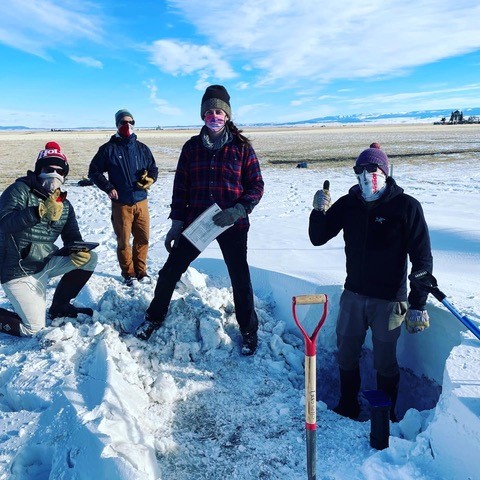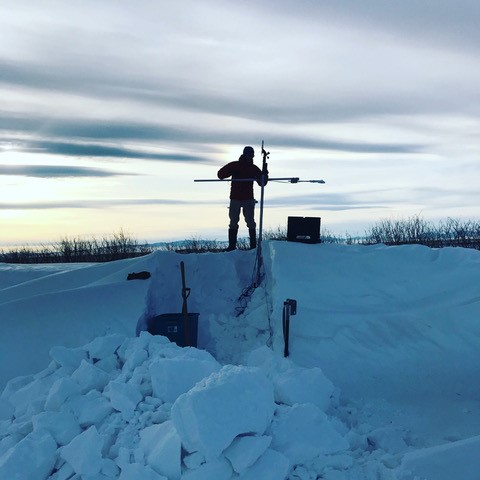Like so many other things, NASA’s SnowEx 2021 looks a little different than usual this year. But one thing is business as usual, and that’s the participation of undergraduate and graduate students.
Students play a pivotal role in SnowEx, from suiting up for data collection to crunching the numbers afterward. The field sites become a classroom for the students too – as they measure, record, process and analyze real data, they learn skills for their own research work.
We invited some of the students from Montana State University to share their experiences in this year’s campaign at the Central Agricultural Research Center (CARC) site. In addition to sharing what their typical days in the field look like, they shared some of the new experiences and discoveries they’ve had, and what they’re enjoying most.
Dr. Eric Sproles, Assistant Professor of Earth Sciences, Montana State University, Site Lead
Wow – this NASA SnowEx project has provided some amazing opportunities for hands-on learning for students and investigators alike. The snow-centric research at Montana State University has primarily focused on mountain snowpacks. Working in the prairie is different in many ways. First, it is much more variable than I imagined. Because of wind and vegetation, snow drifts can be over 3 feet deep in one location, and only 20 yards away you find bare ground. This allows you to really think about the effects of wind and vegetation in this food producing region of the world.
Secondly, measuring the snow in these areas is incredibly challenging, and makes you rethink the way you usually do things. Being forced out of your comfort zone has helped broaden my perspective as a scientist and mentor. We have some amazing students at Montana State, and in these types of hands-on environments, I think I learn as much from them as they do from me.
Leading this SnowEx project has allowed me to better connect with fellow SnowEx Leads, and also other scientists from across the United States with an interest in prairie snow. These professional relationships underscore the value of team-based approaches to big-picture science.
Andrew Mullen, Master’s Student in Earth Sciences, Montana State University
The 2021 SnowEx field campaign has been a unique experience because I have never before participated in such a widespread, coordinated field data collection effort with so many different moving parts. Although we are physically distanced from the other research groups, it feels like we are part of one cohesive effort with the same objectives in mind. We are collecting a vast array of data types using a variety of methods, and I have enjoyed thinking about how we can link different types of data to answer specific questions. Our work here feels meaningful because this data is being used to develop and validate tools and methods that will improve how we monitor snow across the globe for years to come.
My role at the CARC field site has mainly been in conducting UAV-based broadband albedo (reflectivity) surveys of our 1 km x 1 km study area. With these UAV flights, I am mainly interested in observing the spatial variability in albedo across the field area that is composed of many different types of crop cover and microtopography that have a significant impact on the distribution of snow and snow properties. I have also been a part of the manual snow surveys (snow pits and snow depth transects, or predefined lines we measure along) where we are able to observe this variability firsthand.
The nature of this landscape forces you to think differently about processes of snow accumulation and loss that don’t get much attention in the literature. I feel that there is a lot of potential for new and impactful discoveries and insights to be uncovered here, with the quantity and quality of data we are collecting in this landscape that composes such a large portion of the Earth’s land surface. Something I have taken away from this field campaign is an appreciation for this type of landscape both in terms of the complexity in processes as well as its natural beauty.

Guy Brisman White, Undergraduate Student in Earth Sciences, Montana State University
It is a very cool experience to be a part of something that is being used for a larger purpose. As an undergraduate student, I feel that a lot of the work I do is basic and mostly for my own education, so I am happy to contribute to a larger project like SnowEx. Another key experience is learning how data is collected. I have used many different data types throughout my college career, and seeing firsthand how hard it is to record quality data made me appreciate many of the sources I have taken for granted.
Our typical fieldwork days include a long but beautiful drive on often snowy and icy roads. Once we arrive at the site, we have a quick meeting to lay out the fine details of the plan and break into different pairs or groups to complete the tasks. Snow pits were labor-intensive but familiar to me, so I spent the most time working on them. Just a few of the other great learning experiences I had included obtaining weather data from stations, transects, and learning about collecting albedo with drones.
Kendall Wojick, Master’s Student in Land Resource and Environmental Science, Montana State University
Being a part of a NASA research team has been an amazing opportunity to test my fieldwork and teamwork skills in a new setting. I enjoy the responsibility and organization of the data recording set up by NASA. Seeing how they structure their data documentation has improved my personal data housing practices for my graduate studies.
A day in the field for us looking at prairie snowpack is really fun and unique compared to the other mountainous sites in this study. While we don’t get to ski in to our sites, we do get to interact with a beautiful prairie landscape and laugh at how impressive and unexpected the pits we dig are. With the residual berms (flat ridges) of snow that build up near large windbreaks, there are some hefty ice lenses (“bubbles” of ice in rock or soil) from months of melt and freeze patterns that we have to bust through. In order to break through these thick lenses, we even had to employ a “Montana Sharpshooter”, a weighted spade-shaped shovel, that was invented to bust through gravelly concrete-like soils in central Montana. It is always a team effort and a lot of fun to dig and study these pits. I am a soil scientist by trade, so it is an interesting thought experiment to compare how the temporary layers of snow develop compared to the longer-lasting layers of soil. I’ve realized how much snow is truly present on the prairies and what a difference capturing it with wind breaks and stubble can make for dryland agriculture. I feel that the prairies often get overlooked when it comes to snowpack so I am excited that it is included and appreciated in this study.

After a long day of collecting data – which involves a three-hour drive for us – I love getting to know my research partners better, often playing bluegrass on the drive home with a chance to take in the beautiful Montana landscapes. There is something about a shared passion for these landscapes and the open road that opens people up so we can joke, laugh and discuss everything from silly stuff to deep existential ideas about life and existing on this floating ball of water and rock we call Earth. This NASA project is about as close as I’ll get to being an astronaut, but it does make me think about the incredible progress we have made in remote sensing since NASA was formed in the 1950’s and how it has truly moved forward one small step at a time. Every aspect of a pit we collect seems so small in the moment, but when we repeat that a few hundred times, we have something robust. I can’t wait to see the results of this field season and the accuracy of the SAR sensor, and how this mission moves our collective capabilities forward.
